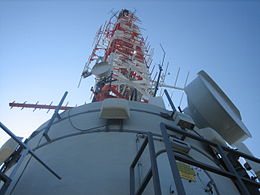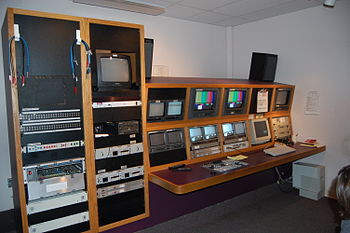- Broadcasting
-
"Broadcast" redirects here. For other uses, see Broadcast (disambiguation).Broadcasting antenna in Stuttgart

Broadcasting is the distribution of audio and video content to a dispersed audience via any audio visual medium. Receiving parties may include the general public or a relatively large subset of thereof. It could also[vague] be for purposes of private recreation, non-commercial exchange of messages, experimentation, self-training, and emergency communication such as amateur (ham) radio and amateur television (ATV).
The term broadcast was first adopted by early radio engineers from the Midwestern United States,[citation needed] treating broadcast sowing as a metaphor for the dispersal inherent in omnidirectional radio signals.[citation needed] Broadcasting is a very large and significant segment[quantify] of the mass media.
Originally all broadcasting was composed of analog signals using analog transmission techniques and more recently broadcasters have switched to digital signals using digital transmission.
- Analog audio vs. HD Radio
- Analog television vs. Digital television
- Wireless
The world’s technological capacity to receive information through one-way broadcast networks more than quadruplet during the two decades from 1986 to 2007, from 432 exabytes of (optimally compressed) information, to 1.9 zettabytes[1]. This is the information equivalent of 55 newspapers per person per day in 1986, and 175 newspapers per person per day by 2007[2].
Contents
Types of electronic broadcasting
Historically, there have been several different types of electronic media broadcasting:
- Telephone broadcasting (1881–1932): the earliest form of electronic broadcasting (not counting data services offered by stock telegraph companies from 1867, if ticker-tapes are excluded from the definition). Telephone broadcasting began with the advent of Théâtrophone ("Theatre Phone") systems, which were telephone-based distribution systems allowing subscribers to listen to live opera and theatre performances over telephone lines, created by French inventor Clément Ader in 1881. Telephone broadcasting also grew to include telephone newspaper services for news and entertainment programming which were introduced in the 1890s, primarily located in large European cities. These telephone-based subscription services were the first examples of electrical/electronic broadcasting and offered a wide variety of programming.
- Radio broadcasting (experimentally from 1906, commercially from 1920): radio broadcasting is an audio (sound) broadcasting service, broadcast through the air as radio waves from a transmitter to an radio antenna and, thus, to a receiver. Stations can be linked in radio networks to broadcast common radio programs, either in broadcast syndication, simulcast or subchannels.
- History of television broadcasting (telecast), experimentally from 1925, commercial television from the 1930s: this television programming medium was long-awaited by the general public and rapidly rose to compete with its older radio-broadcasting sibling.
- Cable radio (also called "cable FM", from 1928) and cable television (from 1932): both via coaxial cable, serving principally as transmission mediums for programming produced at either radio or television stations, with limited production of cable-dedicated programming.
- Direct-broadcast satellite (DBS) (from circa 1974) and satellite radio (from circa 1990): meant for direct-to-home broadcast programming (as opposed to studio network uplinks and downlinks), provides a mix of traditional radio or television broadcast programming, or both, with dedicated satellite radio programming. (See also: Satellite television)
- Webcasting of video/television (from circa 1993) and audio/radio (from circa 1994) streams: offers a mix of traditional radio and television station broadcast programming with dedicated internet radio-webcast programming.
Economic models
Economically there are a few ways in which stations are able to broadcast continually. Each differs in the method by which stations are funded:
- in-kind donations of time and skills by volunteers (common with community radio broadcasters)
- direct government payments or operation of public broadcasters
- indirect government payments, such as radio and television licenses
- grants from foundations or business entities
- selling advertising or sponsorships
- public subscription or membership
Broadcasters may rely on a combination of these business models. For example, National Public Radio (NPR), a non-commercial educational (NCE) public radio media organization within the U.S., receives grants from the Corporation for Public Broadcasting (CPB) (which, in turn, receives funding from the U.S. government), by public membership and by selling "extended credits" to corporations.
Underwriting spots vs. commercials
In contrast with commercial broadcasting, NPR does not carry traditional radio commercials or television commercial. It offers major donors brief statements that are called underwriting spots and unlike commercials, are governed by specific FCC restrictions in addition to the truth-in-advertising laws; they cannot advocate a product or contain any "call to action"
Recorded broadcasts and live broadcasts
The first regular television broadcasts began in 1937. Broadcasts can be classified as "recorded" or "live". The former allows correcting errors, and removing superfluous or undesired material, rearranging it, applying slow-motion and repetitions, and other techniques to enhance the program. However, some live events like sports television can include some of the aspects including slow-motion clips of important goals/hits, etc., in between the live television telecast.
American radio-network broadcasters habitually forbade prerecorded broadcasts in the 1930s and 1940s requiring radio programs played for the Eastern and Central time zones to be repeated three hours later for the Pacific time zone (See: Effects of time on North American broadcasting). This restriction was dropped for special occasions, as in the case of the German dirigible airship Hindenburg disaster at Lakehurst, New Jersey, in 1937. During World War II, prerecorded broadcasts from war correspondents were allowed on U.S. radio. In addition, American radio programs were recorded for playback by Armed Forces Radio radio stations around the world.
A disadvantage of recording first is that the public may know the outcome of an event from another source, which may be a "spoiler". In addition, prerecording prevents live radio announcers from deviating from an officially approved script, as occurred with propaganda broadcasts from Germany in the 1940s and with Radio Moscow in the 1980s.
Many events are advertised as being live, although they are often "recorded live" (sometimes called "live-to-tape"). This is particularly true of performances of musical artists on radio when they visit for an in-studio concert performance. Similar situations have occurred in television production ("The Cosby Show is recorded in front of a live television studio audience") and news broadcasting.
A broadcast may be distributed through several physical means. If coming directly from the radio studio at a single station or television station, it is simply sent through the studio/transmitter link to the transmitter and thence from the television antenna located on the radio masts and towers out to the world. Programming may also come through a communications satellite, played either live or recorded for later transmission. Networks of stations may simulcast the same programming at the same time, originally via microwave link, now usually by satellite.
Distribution to stations or networks may also be through physical media, such as magnetic tape, compact disc (CD), DVD, and sometimes other formats. Usually these are included in another broadcast, such as when electronic news gathering (ENG) returns a story to the station for inclusion on a news programme.
The final leg of broadcast distribution is how the signal gets to the listener or viewer. It may come over the air as with a radio station or television station to an antenna and radio receiver, or may come through cable television [1] or cable radio (or "wireless cable") via the station or directly from a network. The Internet may also bring either internet radio or streaming media television to the recipient, especially with multicasting allowing the signal and bandwidth to be shared.
The term "broadcast network" is often used to distinguish networks that broadcast an over-the-air television signals that can be received using a tuner (television) inside a television set with a television antenna from so-called networks that are broadcast only via cable television (cablecast) or satellite television that uses a dish antenna. The term "broadcast television" can refer to the television programs of such networks.
Legal definitions
United Kingdom
The Copyright, Designs and Patents Act of 1988 defines a broadcast as "a transmission by wireless telegraphy of visual images, sounds, or other information which is capable of lawful reception by the public or which is made for presentation to the public". Thus, it covers radio, television, teletext and telephones.
Social impact
The sequencing of content in a broadcast is called a schedule. As with all technological endeavours, a number of technical terms and slang have developed. A list of these terms can be found at List of broadcasting terms. Television and radio programs are distributed through radio broadcasting or cable, often both simultaneously. By coding signals and having a cable converter box with decoding equipment in homes, the latter also enables subscription-based channels, pay-tv and pay-per-view services.
In his essay, John Durham Peters wrote that communication is a tool used for dissemination. Durham stated, “Dissemination is a lens- sometimes a usefully distorting one- that helps us tackle basic issues such as interaction, presence, and space and time…on the agenda of any future communication theory in general” (Durham, 211). Dissemination focuses on the message being relayed from one main source to one large audience without the exchange of dialogue in between. There’s chance for the message to be tweaked or corrupted once the main source releases it. There is really no way to predetermine how the larger population or audience will absorb the message. They can choose to listen, analyze, or simply ignore it. Dissemination in communication is widely used in the world of broadcasting.
Broadcasting focuses on getting one message out and it is up to the general public to do what they wish with it. Durham also states that broadcasting is used to address an open ended destination (Durham, 212). There are many forms of broadcast, but they all aim to distribute a signal that will reach the target audience. Broadcasting can arrange audiences into entire assemblies (Durham, 213).
In terms of media broadcasting, a radio show can gather a large number of followers who tune in every day to specifically listen to that specific disc jockey. The disc jockey follows the script for his or her radio show and just talks into the microphone. He or she does not expect immediate feedback from any listeners. The message is broadcast across airwaves throughout the community, but there the listeners cannot always respond immediately, especially since many radio shows are recorded prior to the actual air time.
See also
- 1worldspace – world's first commercial satellite radio direct-to-home broadcaster
- Analog television
- Bandplan
- Broadcast television systems – contains the standards of the topic
- Broadcast safe
- Broadcast license
- Broadcasting network
- Broadcast quality
- Cablecast
- Dead air
- Digital television
- Electronic media
- European Broadcasting Union (EBU)
- History of broadcasting
- Internet radio
- Internet television
- List of broadcasting terms
- List of broadcast satellites
- NaSTA
- Nonbroadcast Multiple Access Network (NBMA)
- North American broadcast television frequencies
- Outside broadcast
- Radio Act of 1927
- Reality television
- Society of Broadcast Engineers (SBE)
- Streaming media
- Television studio
- Television transmitter
- Transposer
- Television broadcasting in Australia
- Web television
- Webcast
Notes
- ^ "The World’s Technological Capacity to Store, Communicate, and Compute Information", Martin Hilbert and Priscila López (2011), Science (journal), 332(6025), 60-65; free access to the article through here: martinhilbert.net/WorldInfoCapacity.html
- ^ "video animation on The World’s Technological Capacity to Store, Communicate, and Compute Information from 1986 to 2010
Bibliography
- Carey, James (1989) Communication as Culture, Routledge, New York and London, pp. 201–30
- Kahn, Frank J., ed. Documents of American Broadcasting, fourth edition (Prentice-Hall, Inc., 1984).
- Lichty Lawrence W., and Topping Malachi C., eds. American Broadcasting: A Source Book on the History of Radio and Television (Hastings House, 1975).
- Meyrowitz, Joshua., Mediating Communication: What Happens? in Downing, J., Mohammadi, A., and Sreberny-Mohammadi, A., (eds) Questioning The Media (Sage, Thousand Oaks, 1995) pp. 39–53
- Peters, John Durham. "Communication as Dissemination." Communication as…Perspectives on Theory. Thousand Oakes, CA: Sage, 2006. 211-22.
- Thompson, J., The Media and Modernity, in Mackay, H and O'Sullivan, T (eds) The Media Reader: Continuity and Transformation., (Sage, London, 1999) pp. 12–27
Further reading
- Gilbert, Sean; Nelson, John; Jacobs, George, World Radio TV Handbook 2007, Watson-Guptill, 2006. ISBN 0953586499. The 2007 edition of the World Radio TV Handbook.
- Wells, Alan, World Broadcasting: A Comparative View, Greenwood Publishing Group, 1996. ISBN 1567502458
External links
- Radio Locator, for American radio station with format, power, and coverage information.
- Jim Hawkins' Radio and Broadcast Technology Page – History of broadcast transmitter technology
Broadcasting Medium Telephone · Television (cable television · satellite television · broadcast programming) · Radio broadcasting (cable radio · satellite radio · Radio programming) · Webcast (streaming media · Internet radio · Web television · Internet television) · teletextBroadcaster niche Content niche Specialty channel (men's interest channel · Adult entertainment · women's interest channel · Children's interest channel/children's television series · documentary channel · public affairs · Film entertainment · music television/music radio · News broadcasting · quiz channel · shopping channel · Sports · talk radio)Production and funding Television licence · Digital on-screen graphic · score bug · news ticker · lower thirds · television studio · broadcast safe · broadcast license · broadcast network · Broadcast television systems · Network affiliateCategories:- Broadcasting
- Television terminology
Wikimedia Foundation. 2010.



